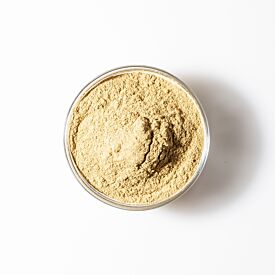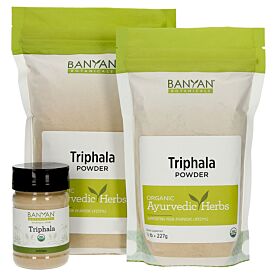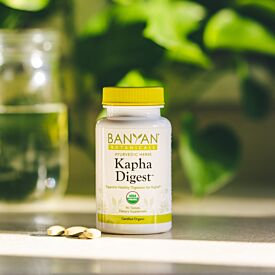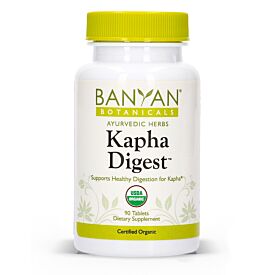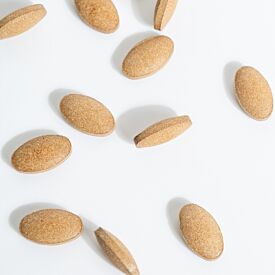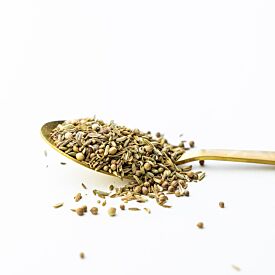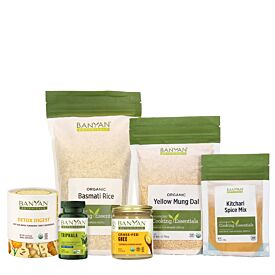Fall Cleanse for Kapha

In this article:
- Give Thanks to Your Body
- What to Expect
- Planning for Your Cleanse
- Daily Routine During the Cleanse
- Transitioning Back into Normal Life
- Recipes
- Shopping List
- Additional Resources
Give Thanks to Your Body
Your body is remarkably intelligent and incredibly hard working. Day in and day out, it processes all kinds of inputs—distinguishing what’s good for you from what’s not, doing its best to eliminate any harmful substances alongside routine metabolic waste.
But these days, our bodies are inundated with a never-ending barrage of stressors: environmental toxins, processed foods, unresolved emotions, and psychological stress, to name a few.
Inevitably, in attempting to “digest” it all, we accumulate some degree of toxicity—which, over time, can build up in the system, deposit in the tissues, and compromise our health. But there is something you can do to give your body a break.
Actually, this is precisely the idea behind an Ayurvedic cleanse: to slow the flood so that the body can rest, recuperate, and repair itself. And amazingly, when the deluge of inputs slows, your body will immediately take advantage of the lull to do some very deep cleaning.
An Ayurvedic cleanse serves to rest and purify the digestive system while addressing the root cause of any imbalances. The entire process works to draw toxins out of the tissues and into the digestive tract so that they can be eliminated, and simultaneously removes excess vata, pitta, and kapha to promote improved balance and overall health.
Below, you will find everything you need to implement a simple, food-based cleanse at home this fall. However, even a gentle cleanse like this one is not appropriate for pregnant or breastfeeding women, or anyone who is extremely weak or debilitated.
On the other hand, if you are considering becoming pregnant, Ayurveda highly recommends that both partners undertake a cleanse approximately three months prior to conception.
What to Expect
A traditional Ayurvedic cleanse involves four distinct phases, each critically important to your success:
1. Preparation
Three Days Prior to the Cleanse (longer, if possible)
For a few days leading up to your cleanse, focus on cleaning up your diet and habits to prepare the body for an effective cleanse.
You will want to eliminate (or at least dramatically reduce) your use of:
- Coffee or caffeine.
- Tobacco products.
- Alcohol or any recreational drugs.
- Fast foods or processed foods.
- Meats.
- Refined sugars and sweets.
During this time, eat as many simple, whole foods as possible, including:
- Fruits.
- Vegetables.
- Whole grains.
- Nuts.
- Seeds.
2. Active Cleansing
Core Seven Days of the Cleanse
This is the heart of the cleanse. During this time, you will eat a very simplified monodiet of kitchari (basmati rice cooked with yellow mung dal). This diet is substantive enough that you can maintain your essential responsibilities, but it simultaneously resets the digestive system, supports the elimination of toxins, and balances vata, pitta, and kapha.
During this seven-day period, other cleansing practices such as abhyanga (Ayurvedic oil massage), gentle exercise, and detoxifying herbs can enhance the impact of the cleanse.
3. Reintroduction
Three Days Following the Cleanse (longer, if possible)
Even after you complete the seventh day of the cleanse, your body will still be processing the toxins that were stirred into circulation.
In addition, your digestive system will have become accustomed to a very clean diet and will be somewhat sensitive to overly stimulating or processed foods. Therefore, a slow transition back into your normal routine and a more diverse diet is critically important.
This three-day period is a chance to buffer your system and to rekindle your agni (digestive fire) so that it can handle more complex foods. Again, eat primarily simple, whole foods, diversifying your menu very gradually.
If possible, take this time to test the waters with foods that are potentially aggravating like dairy, wheat, and soy—ideally, reintroducing these foods one at a time and giving yourself up to twenty-four hours to observe how your body responds to each one.
4. Rejuvenation
Up to Three Months Following the Completion of the Cleanse
This is the final step in any Ayurvedic cleanse. Now that you’ve cleared your body of accumulated toxins and imbalances, your tissues are primed to receive very deep nourishment.
Rejuvenating foods and practices are usually sweet and comforting, and most people find this phase of the cleanse quite enjoyable.
For more on the Ayurvedic tradition of rasayana (rejuvenation), please see our Rejuvenation Department.
Planning for Your Cleanse
As you can see, the active cleansing phase of this particular cleanse is seven days in length, but the full cleansing process takes about two weeks, and is followed by a period of rejuvenation. This timeframe allows for proper preparation before the cleanse, and eases you slowly back into your normal routine afterward.
At a minimum, eliminate any unnecessary obligations and give yourself as much unscheduled time to rest as possible—especially during the active cleansing phase.
Also, those menstruating should schedule their cleanse around their cycle to ensure that they are not bleeding during the seven days of active cleansing. If menstruation comes unexpectedly, they can continue on the kitchari diet, but should suspend all other practices (abhyanga, nasya, triphala, etc.) until menstruation is complete.
Please Note: the two-week timeframe outlined here is ideal, but if you don't have two weeks to give to a cleanse, you can shorten the phases in proportion to one another. For example, you might do one to two days of preparation, three to four days of cleansing, one to two days of reintroduction, and one to two months of rejuvenation.

Daily Routine During the Seven-Day Cleanse
Freshly-prepared foods are best for your cleanse, so you’ll want to cook your breakfast grains and kitchari fresh each day—at whatever time works best with your schedule.
It is perfectly acceptable to prepare all of your food for the day first thing in the morning, but you'll want to avoid eating leftovers from previous days throughout the cleanse.
Morning Routine
Wake Up Early. Rise early so that you can complete your morning routine before breakfast.
Scrape Tongue and Brush Teeth. Upon waking, scrape your tongue with a tongue cleaner and brush your teeth with a natural formula like tooth powder.
Practice Nasya. Administer Nasya Oil (three to five drops in each nostril).
Drink Hot Water. Sip 8–16 ounces of hot water to cleanse the system and to awaken the digestive capacity.
Practice Self-Massage (optional). Abhyanga (Ayurvedic self-massage) helps loosen and move toxins stored in the tissues toward the digestive tract so that they can be eliminated. Recommended oils for kapha include Organic Sesame Oil or Kapha Massage Oil. For maximum benefit, let the oil soak in for about twenty minutes.
Take a Steam Bath (optional). If you have access to a steam room or sauna, let your oil soak in as you sit just long enough to break a sweat. Otherwise, you can warm your bathroom with a space heater and create a little steam with hot water from the shower. It is important not to get chilled.
Take a Bath or Shower. Use a natural soap only where needed (ideally not all over the body). If you are doing abhyanga daily, here are some additional considerations:
- Take care not to slip on oily surfaces; consider washing your feet first.
- Excess oil will rinse off with water.
- If you do not need to go out, it is fine to leave some oil in your hair.
- Otherwise, you may need to shampoo more than once to remove all of the oil. You can also try applying shampoo to your dry hair (before you wet it), lather, then rinse. For many, this method cuts the oil more effectively.
- Use a designated towel to pat dry (this towel will become oily over time).
Do Some Gentle Exercise. Slow, gentle movements will support cleansing; more than that can be counterproductive. This is not a time to push yourself. Consider walking, tai chi, qigong, or a grounding yoga practice such as vata-pacifying yoga (which is seasonally appropriate and gentle enough for a cleanse).
Eat Breakfast. Favor rice porridge, seasoned barley, or kitchari: as much as desired (do not overeat).
Throughout the Day
Stick to Three Meals per Day. Eat kitchari throughout the day, as desired, garnished with fresh coriander chutney or sesame seed chutney. Allow at least three hours between meals. Be sure to eat enough food and have enough variety so that you truly feel satisfied and at peace with this process.
Avoid Snacking. If you need a little something extra, you can enjoy some fresh fruit or a few raw nuts. It is very important not to feel deprived during your cleanse.
Eat Dinner Early. Try not to eat after 6 p.m. or 7 p.m. at the latest.
Stay Hydrated. Drink at least three liters of room temperature, warm, or hot fluids each day to ensure adequate hydration and to help flush toxins as they are released. Ideally, take most of your fluids between meals. Appropriate fluids include water, ginger turmeric tea, rehydration tea, and detox teas like Detox Digest. Drink as much of these as you like.
Evening Routine
Take Triphala. About a half-hour before bed, steep ½ teaspoon Triphala powder in a cup of freshly boiled water for ten minutes. Cool and drink. Or, take two Triphala tablets with a glass of water.
Retire for the Night. Getting a good night’s sleep is important for your overall health. Sleep is also the body’s best time to detox, so be sure to get plenty of rest during the cleanse.
Making Supportive Lifestyle Choices
- Keep your activities as quiet and mindful as possible.
- Surround yourself with things that you find uplifting and nourishing.
- Minimize stress and exposure to frantic or disturbing environments.
- A cleanse can stir up unresolved emotions so it is important to be prepared for some emotional purging as well. If intense emotions arise during or after your cleanse, greet your emotions with compassion, observe them with detached awareness, and allow them simply to move through—honoring yourself in the process.
- Rest as much as possible. You can ensure that the bulk of your energy is devoted to cleansing by minimizing the number of resources that your body allocates elsewhere.

Transitioning Back into Your Normal Life
Toward the end of the cleanse, take some time to reflect on your life so that you can move forward with whatever new intentions feel important to you at this time.
Even after you’ve moved through a defined period of reintroduction, understand that it may take some time—two weeks, a month, or longer—before you are able to fully appreciate the benefits of your cleanse.
The body is often still working to eliminate the toxins released during the cleanse, so this is completely normal. It is really important to cultivate inner awareness and listen to your body as you transition back into a healthy diet and lifestyle.
As you do this, you can move into the final phase of the process—known in Ayurveda as rasayana, or rejuvenation—a period of time to offer your tissues deep nourishment.
Recipes
These delicious recipes have been provided courtesy of Dr. Scott Blossom. Remember that your food will absorb the energy of your mindset and state of being while cooking, so you can assist your healing process by bringing good intentions and a sense of presence to your kitchen.
- Seasoned Barley
- Kapha Reducing Kitchari
- Fresh Coriander Chutney
- Sesame Seed Chutney
- Alakananda Ma’s Rehydration Tea
Shopping List
Herbs & Products
- Organic Sesame Oil or Kapha Massage Oil
- Nasya Oil
- Triphala powder or Triphala tablets
- Tongue Cleaner
- Brahmi/Gotu Kola powder (optional)
- Kapha Digest (optional)
Groceries
- Organic White Basmati Rice, about 3 pounds
- Organic Yellow Mung Dal or organic whole mung beans (available in the bulk section of most health food stores), about 1½ pounds
- Barley, dry (optional)
- Organic Ghee (available at most health food stores)
- Organic roasted sesame seeds (optional)
- Kombu or wakame (optional) (available at most health food stores)
Vegetables such as:
- Burdock root
- Zucchini
- Green beans
- Leafy greens (kale or collard greens)
- Onion
Spices and garnishes to have on hand:
- Bay leaves
- Brown mustard seeds
- Black pepper
- Cayenne pepper (optional—use only a pinch so as not to aggravate pitta)
- Cilantro
- Coconut, unsweetened and shredded
- Coriander powder
- Coriander seeds
- Cumin seeds
- Fennel seeds
- Ginger root, fresh
- Fresh mint or dried peppermint
- Hing (asafoetida)
- Lemons
- Limes
- Oregano
- Sage, dried
- Natural mineral salt or sea salt
- Sweeteners: raw honey (best choice for kapha), and/or turbinado sugar
- Turmeric root, fresh (optional)
- Turmeric powder
Cleanse Products
Or, save time and money with one of Banyan’s cleanse products:
- Banyan's Kitchari Kit contains a seven-day supply of Organic Basmati Rice and Organic Yellow Mung Dal, as well as Kitchari Spice Mix and Organic Ghee.
- For an even more convenient and customizable option, Banyan’s Cleanse Bundle allows you to select which items you’d like, and also features CCF Tea.
Additional Resources
Ayurveda offers a number of different approaches to cleansing. For example, panchakarma is Ayurveda's signature cleanse and is more extensive and in-depth than the gentle, food-based home cleanse discussed here.
While panchakarma offers profound benefits, it requires a more complete withdrawal from daily activity and should only be performed under the guidance of an experienced Ayurvedic practitioner.
If you are hungry for more information on cleansing, or if you are not quite sure that the structure of this fall cleanse is the best fit for you at this time, our cleansing department offers a wide range of relevant resources, as well as instructions on several different approaches to cleansing—from a simple one-day digestive reset to a customizable traditional Ayurvedic cleanse.
If you are looking for a more in-depth resource on the Ayurvedic approach to cleansing, please download our Ayurvedic Cleanse Ebook.

